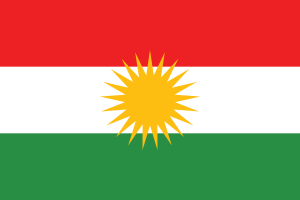Language/Northern-kurdish/Vocabulary/Asking-for-and-Giving-Personal-Information
| ◀️ Introducing Yourself — Previous Lesson | Next Lesson — Nominative Case ▶️ |
Introduction[edit | edit source]
In this lesson, we will focus on asking for and giving personal information in Northern Kurdish. This is an essential aspect of communication as it allows us to get to know each other better and establish connections. By the end of this lesson, you will be able to confidently ask and answer questions about your name, age, nationality, and more. We will provide you with a comprehensive guide that includes vocabulary, grammar structures, and cultural insights to enhance your learning experience. So let's get started!
Vocabulary[edit | edit source]
Before we dive into the grammar and sentence structures, let's begin by learning some important vocabulary related to personal information. Familiarize yourself with the Northern Kurdish terms, their pronunciation, and English translations in the table below:
| Northern Kurdish | Pronunciation | English Translation |
|---|---|---|
| Navê min | [nav-e min] | My name |
| Çi navê te ye? | [chi nav-e te ye] | What is your name? |
| Ez êştim | [ez eshtim] | I am hungry |
| Çend salî te? | [chend sali te] | How old are you? |
| Xwendkar | [xwendkar] | Student |
| Kar | [kar] | Work/Job |
| Civata min | [jivata min] | My nationality |
| Çi welatî ye? | [chi welati ye] | What is your nationality? |
| Mala min | [mala min] | My house |
| Li ku derê tune? | [li ku dere tune] | Where do you live? |
Take your time to practice the pronunciation of these words. Remember that listening and speaking skills are equally important in language learning. Try repeating the words after the pronunciation guide to improve your Northern Kurdish accent.
Grammar[edit | edit source]
Now that you have learned the basic vocabulary, let's explore the grammar structures required for asking and giving personal information.
Asking for Personal Information[edit | edit source]
To ask someone's name in Northern Kurdish, you can use the phrase "Çi navê te ye?" which translates to "What is your name?" Let's break down this sentence:
- "Çi" means "what."
- "Navê" means "name."
- "Te" is the second person singular pronoun, corresponding to "you."
- "Ye" means "is" and functions as the linking verb.
Here are a few examples of how to ask for personal information:
- Çi navê te ye? - What is your name?
- Çi welatî ye? - What is your nationality?
- Çend salî te? - How old are you?
- Li ku derê tune? - Where do you live?
Giving Personal Information[edit | edit source]
To answer these questions, you need to provide the relevant personal information. Here are some examples:
- Navê min Diyar e. - My name is Diyar.
- Ez Kurd im. - I am Kurdish.
- Ez 25 salî me. - I am 25 years old.
- Ez li Stenbolê dijîm. - I live in Istanbul.
In these examples, "min" is the first person singular pronoun meaning "I" and "ez" is the first person singular pronoun meaning "I am." It is essential to note that Northern Kurdish has different pronouns based on gender and number. Make sure to use the appropriate pronoun according to the context.
Cultural Insights[edit | edit source]
Northern Kurdish culture values personal connections and hospitality. When meeting someone for the first time, it is common to exchange personal information as a way to establish a bond. Northern Kurdish people often use formal language when meeting older individuals or those in positions of authority. However, when meeting peers or friends, informal language is more common, and people often address each other by their first names.
In Northern Kurdistan, it is also customary to offer tea or coffee as a gesture of hospitality. When visiting someone's house, it is polite to bring a small gift, such as flowers or sweets. These cultural practices reflect the importance of community and social relationships in Northern Kurdish society.
Practice Exercise[edit | edit source]
Now it's time to practice what you have learned. Complete the following exercises by asking and giving personal information in Northern Kurdish. We will provide you with the solutions and explanations afterwards.
Exercise 1: Ask for personal information.
1. ___________ - What is your name? 2. ___________ - How old are you? 3. ___________ - Where do you live? 4. ___________ - What is your nationality?
Exercise 2: Give personal information.
1. Navê min ___________. 2. Ez ___________. 3. Ez ___________ salî me. 4. Ez li ___________ dijîm.
Exercise Solutions[edit | edit source]
Exercise 1: Ask for personal information.
1. Çi navê te ye? 2. Çend salî te? 3. Li ku derê tune? 4. Çi welatî ye?
Exercise 2: Give personal information.
1. Navê min Diyar e. 2. Ez Kurd im. 3. Ez 25 salî me. 4. Ez li Stenbolê dijîm.
Conclusion[edit | edit source]
Congratulations! You have successfully learned how to ask for and give personal information in Northern Kurdish. This essential skill will help you establish connections and communicate effectively with others. Remember to practice regularly to reinforce your knowledge and improve your fluency. In the next lesson, we will explore more vocabulary and grammar structures related to greetings and introductions. We look forward to seeing you there!
Other Lessons[edit | edit source]
- Health
- Animals
- Introducing Yourself
- Food
- Drinks
- Education
- Greetings
- Fruits
- Indoor Activities
- How to Say Hello and Greetings
Template:Northern-kurdish-Page-Bottom
| ◀️ Introducing Yourself — Previous Lesson | Next Lesson — Nominative Case ▶️ |

